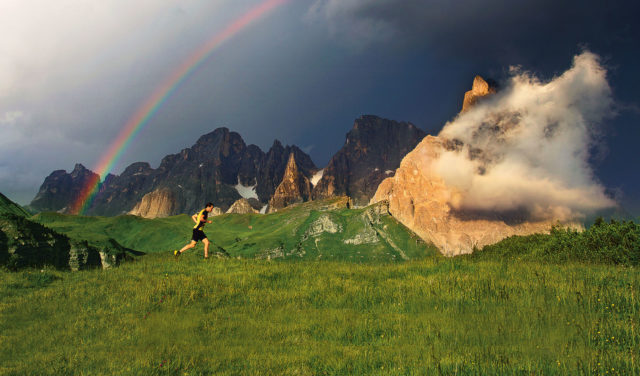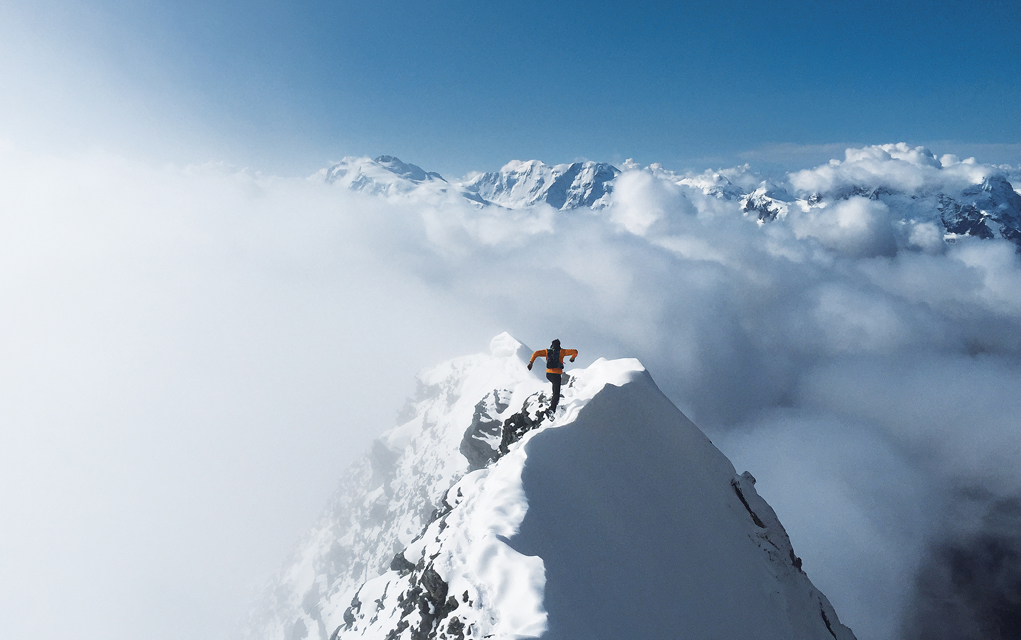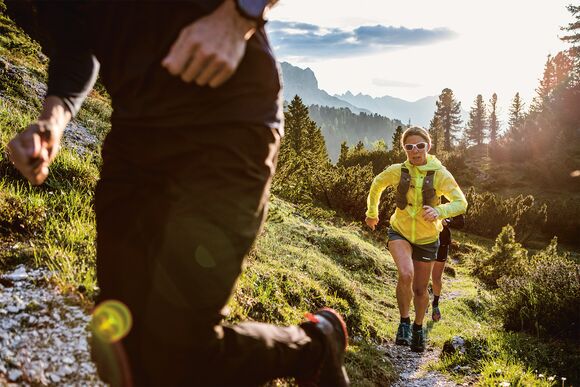
Down the tunnel of his headlamp light, Luke Nelson saw a frog. It sat in the middle of the trail, somewhere around 9,000 feet above sea level in the Italian Alps. He didn’t believe it. For the last few hours, outside the scope of his headlamp, in the corner of his eyes, he’d been catching glimpses of squids wrapping themselves around trees. Octopi were slithering between roots. Once, a moose appeared behind a rock. Italy definitely doesn’t have moose, let alone alpine sea creatures.
But Nelson, a seasoned ultra-running athlete now living in Idaho, wasn’t necessarily surprised. He was deep into a 219-mile race called the Tor des Geants — an iconic network of trails that leads runners up and over 25 mountain passes (89,000 feet of elevation gain total, or the equivalent of climbing Mt. Everest three times). Elite racers typically finish it between 70 and 80 hours.
At a certain point, hallucinations are part of the ultra-endurance racing job. The frog, though, sitting in Nelson’s headlamp spotlight — that seemed eerily real. Nelson paused long enough to take out his phone and snap a picture. He squinted, holding the screen up close to his eyes. The frog was there alright, real in the flesh. He stepped over it and continued onwards, pushing ahead on the midnight trails, outside his element just as much as the frog seemed to be in this high-altitude, low-temperature, mountainous setting.
But that’s exactly the point for Nelson — getting outside his comfort zone. Less than a year earlier, he’d approached his running coach, Scott Johnston, with a desire to expand his athletic repertoire.
“I wanted to start exploring objectives bigger than what I know I already can do,” Nelson says, having already completed several 100-mile trail-running races (winning many), finishing the notoriously challenging “Nolan’s 14” (a 100-ish-mile traverse of 14 Colorado fourteeners), and also setting a speed record for linking all of Utah’s 13,000-foot peaks, all the while working as a physician’s assistant during the day and parenting three kids alongside his wife. “I wanted to keep exploring the impossible.”
Scott Johnston, then, was the perfect coach.

About a decade earlier, Johnston had started training Steve House, a mountain athlete the legendary Reinhold Messner once called “the best high-altitude climber in the world.” Johnston has spent his whole life developing a keen, in-depth understanding of training and exercise science, first as a Boulder teenager learning to climb, then as a competitive collegiate swimmer, and eventually as a world-class cross-country ski competitor and coach. Under his watchful eye, House’s climbing career bloomed.
When House published his first book, Beyond the Mountain, a collection of climbing stories that reflect the trials and tribulations of being a world-class alpinist, he embarked on a nationwide tour and everyone wanted to know the how underlying his athletic accomplishments. “People wanted to hear a simple answer: I ran, hiked uphill, etcetera,” House recalls. “But, you know, there’s a lot of things involved. My answer had become: ‘Well I’d tell you, but I’d have to write another book.’”
So, that’s exactly what House and Johnston did. They teamed up to co-author Training for the New Alpinism: A Manual for the Climber as Athlete (March 2014) and together the duo transformed the entire mountain-endurance community.
“The culture of training for climbing or mountaineering didn’t really exist before we wrote this,” Johnston says. Until Training for the New Alpinism hit bookshelves, there was no central training resource for alpinists working towards big mountain objectives. You simply got better at being an alpinist (that is, climbing in environments too harsh or too high in altitude for trees to grow) by doing a lot of it. Nothing was very efficient or necessarily reliable.
What they thought might sell a few thousand copies snowballed into tens of thousands of copies. Training for the New Alpinism details the how and why behind training methods primed for athletes spending long, intensive days in the mountains. It quietly became a staple on mountaineering shelves, the bible of serious alpinists. Before long, though, it was clear alpinists weren’t the only ones interested in the science and wisdom embedded within its relatable, easily understood pages.

Other “uphill athletes” like ski-mountaineers, skimo racers and mountain runners were trying to adapt the book to meet their needs, too — as it was the closest thing the endurance community had ever seen to a canon acknowledging their needs.
Kilian Jornet, arguably the most accomplished and well-rounded uphill athlete of current times, read Training for the New Alpinism and posted on social media shortly after. He lauded praise, but yearned for more: a book geared specifically toward fast uphill movement, not just for slower-moving alpinism (where one often carries a much heavier pack and navigates more technical terrain). So, Jornet, House and Johnston got to talking.
Jornet has a strong background in physiology, as he studied it in college, and has been training since his youth in Spain. His list of athletic accolades would run off this page, but includes summiting Everest twice in one week and setting speed records on worldwide iconic peaks. As a self-coached athlete prioritizing his mind-body connection, Jornet was able to offer Johnston and House valuable uphill training insight that meshed perfectly with the ethos that guides Training for the New Alpinism: “If you understand everything [about your body] well and remain objective, you could possibility become the most precise coach for yourself,” as Johnston describes it. Their goal has always been to empower athletes with their own knowledge and motivation.
The need for another training book had only grown clearer with time, House says. “People kept emailing us the same questions,” asking about adaptations for different skiing and running objectives.
Not long after, House, Johnston and Jornet began collaborating on a new book, Training for the Uphill Athlete: A Manual for Mountain Runners and Ski Mountaineers (March 2019), which spends 368 pages integrating Jornet’s expertise, House’s experiences and Johnston’s intellect into one cohesive guide.

Like House and Johnston’s first book, it’s an interdisciplinary approach to success in a nontraditional sport. “We didn’t invent anything new here. All we did was apply conventional sports training methodologies to this unusual activity,” Johnston says. “This is our attempt to bring the conversation back to reality, to say: ‘[We] want to make this accessible to any interested amateur who wants to know what professional athletes do for training, and how and why it works,’” Johnston says.
As with Training for the New Alpinism, Training for the Uphill Athlete doesn’t provide any singular, one-size-fits-all training plan. The authors intend for readers to absorb the science and use it to build their own plans. “Training has to be individualized to the athlete,” Johnston says. The books are “what we wish we’d had when we were young and starting out.”
Equipping today’s athletes with expert training advice will set the stage for new athletic achievements. “It’s happened in every other sport, like swimming, climbing,” Johnston says. “I don’t see why not in this sport. We’re very likely to see better performance [in the mountains].”
If anything, Luke Nelson’s experience (plus that of National Geographic photographer Cory Richards and climber Anna Pfaff, among many more world-class athletes) makes a strong case using the trio’s methods. “The secret sauce is all there. And the secret is that there’s no secret. It’s hard work and it’s all these very sound, proven training techniques, but laid out in a way that you can understand them and then apply it to your own training,” Nelson says.
Nelson placed eighth in the Tor des Geants, finishing in over 85 hours. He says House and Johnston “are absolute legends within their fields. That the larger community gets to now tap into who they are and this resource is just going to change the sport.”
ON THE BILL: Training for the Uphill Athlete Book Tour. 7:30 p.m. Wednesday, May 22, Patagonia Boulder. 1212 Pearl St. uphillathlete.com















